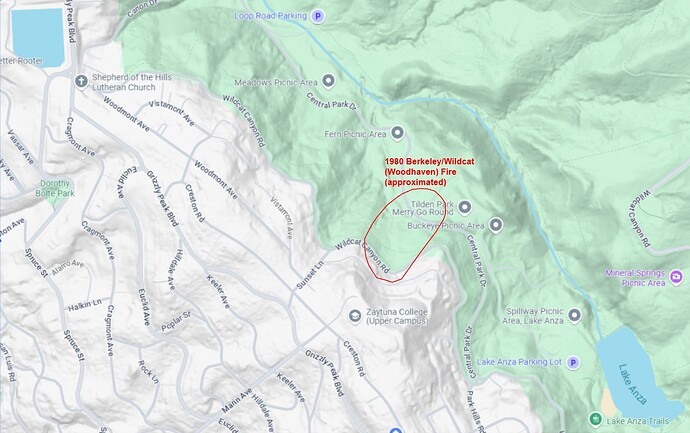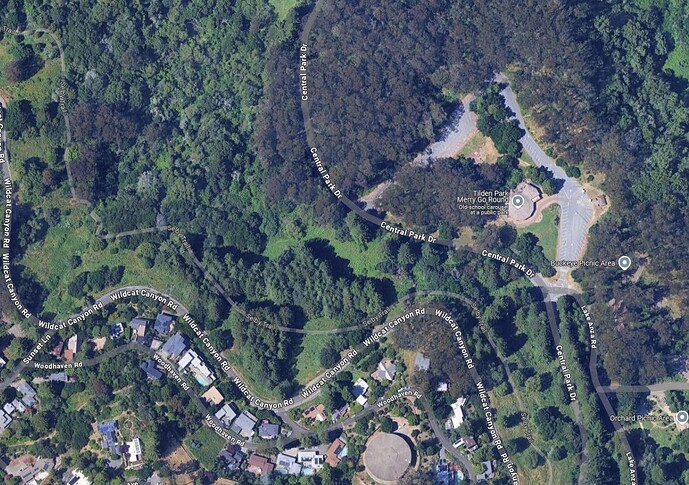While there have been other urban fires in “Zone 4” (Berkeley Hills East of Grizzly Peak) in the past 15 years, the most recent wildfire to hit Zone 4 is the 1980 Berkeley/Wildcat Fire.
Not much has been published on this fire. The incident summary mentions:
- December 1980 - Berkeley/ Wildcat: 5 homes, 2 acres, on a Saturday afternoon. Diablo wind. Ignition: power line. Quote: “the blaze, fed by thick underbrush and tree (eucalyptus) debris, was so hot and fast that homes literally exploded” (from Background Report: The East Bay Hills Wildfire Problem Statement | East Bay Parks).
Our interpretation: the fire was very circumcised, and generated relatively few embers due to its limited size. Despite that, it burned very hot, was able to jump over Wildcat easily, and almost immediately lit up two structures on Woodhaven, right alongside the edge of Tilden. It looks like, because of the limited amount of embers, the fire department was able to stop the fire right as it had jumped over Wildcat into Berkeley. Based on the behavior of other large wildfires such as the Paradise (Camp Fire) or the SoCal fires, it seems that the only likely reason the fire was well and quickly controlled is that the ignition point was so close to Wildcat Canyon that there were very few embers, comparatively, flying into Berkeley.
Why/how did it get controlled quickly?
What follows is our analysis. The ignition point was extremely close to the edge of Berkeley: the total extent of the fire was only 2 acres. As a result:
- the fire was reported almost immediately
- there were, relatively few embers flying out from Tilden into Berkeley
So this was no massive ember storm menacing a whole neighborhood. Nonetheless, because the ignition was so close to Berkeley, the fire immediately ignited 5 structures, which is already beyond the capacity of BFD alone, since one structure requires 15 firefighters and 5-7 firefighting vehicles. Berkeley must have had help from neighboring departments in order to extinguish this fire—they clearly performed extremely well.
What we can see today
We know that the wildfire destroyed homes on Woodhaven, and that most of the burnt ground was in Tilden. The satellite view today shows no apparent trace of a past fire:
Update
We recently heard the reminiscences of a local resident who was present at the time and living nearby. Here are her recollections:
"In the late 70’s or early eighties during a Diablo wind event, a fire whooshed up from Tilden and burned 6 houses, I believe. The fire was only a couple of houses wide and came so fast it burned only one side of the trees it passed. The BFD with help of other [fire] departments and a helicopter extinguished the fire quickly. Has anyone reviewed that event and how it was put out so quickly ? Or why it did not widen? Or the fact that the embers blew over top, not touching the houses on the crest, but falling forward down the west hillside. I remember it as I was just a few houses to the south and two houses to the west of the burn. "
Her memories are so interesting! They match exactly the behavior that would be expected. Since it was a Diablo wind event—we would expect the embers to blow largely following a linear flow model all the way up to the Berkeley Ridge itself, and them be caught by turbulence west of the ridge and land in a wide area on the west hillside of the Berkeley Ridge. If any embers had caught on this side, fire would have very quickly run back uphill (about 15 times faster than in flat ground, given the average slope), pushed by turbulences running in an easterly-going direction (since the strong Diablo wind is going west to southwest, the turbulent eddy on the west of the ridge would likely blow east or northeast) on the leeward side of the Ridge, and possibly catching the residents of the Ridge between two fires.
This is exactly how we expect the next Ridge fire to occur—ignitions coming from the east, and other ignitions (from embers) coming from the west hillside. If the ignitions on the west hillside start moving uphill, it will become a very dangerous situation for the trapped residents living on Grizzly Peak and east.
As a note, the use of at least one helicopter confirms our earlier assumption that BFD had some outside help with this fire, which, despite its limited scope, had already grown beyond the means of a single fire department.

